Coast Salish baskets
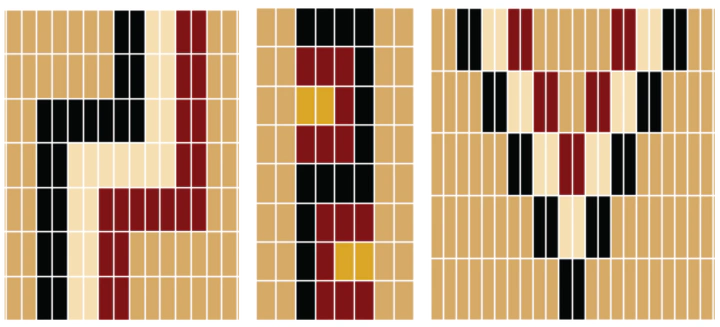
What geometric concepts can be seen in the traditional weaving of the Coast Salish people?
Grades 5 - 9
Weaving is a craft with a long history in many places around the world, including the Pacific Northwest. Woven baskets, in particular, have long been important practical and cultural objects for BC Coast Salish people. An important feature of woven baskets is the occurrence of beautiful geometric motifs/patterns, such as the ones on the basket below, exhibited at the Museum of Anthropology.
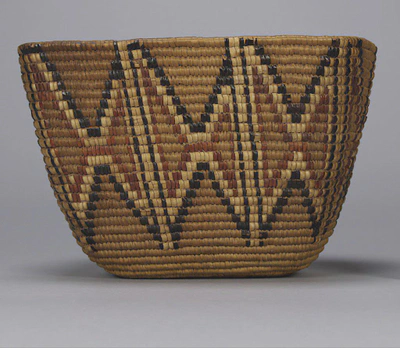
The motifs we observe on many Coast Salish baskets are highly regular and can be described very simply in terms of basic geometric shapes and mathematical operations.
Motifs
The basic geometric shapes or motifs include broken lines, triangles, rectangles, and more. Here are three: the broken line, the atomic snake, and the triangle:
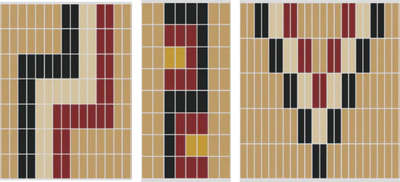
The number of lines, height and width can be adjusted to suit the artist's vision of the weaver.
Mathematical Operations
These motifs can be repeated using the geometric operations of flipping and reflecting as well as stacking copies of the basic shape. Here are the basic reflections:
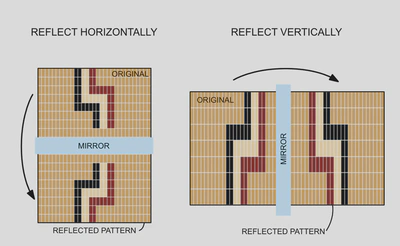
Here are the basic stacking operations:
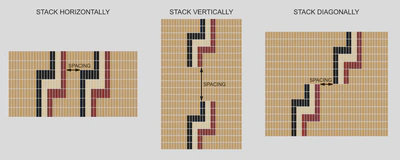
Finally, these combined patterns can be woven into the shape of a basket, as in the graphical representation here. Notice we can have both rectangular and circular baskets of all sorts of shapes and sizes.
Some questions you might like to explore with these visualizations:
- What are the basic shapes that one can create when weaving?
- What complex shapes can you make from these basic shapes?
- What happens when you combine reflections with stacking?
- Does the order matter? Stack then reflect, or reflect then stack - are they the same?
- Where can you find other examples of real baskets made by Indigenous people?
Suggestions for further exploration
- Can you make real weavings yourself using materials around the classroom or at home?
Reflect on what you see
Look and interact with the graphical visualizations above. Some of them are “live” and will rotate at the touch of a button. You can click on the 3D basket and rotate it around to examine all sides of it.
Think about the following questions.
- What symmetries are there on the various sides of the basket?
- Does the circular basket have to have 4 copies of the pattern? Are other numbers of copies possible?
Use the fill-in-the-blank prompts to summarize your thoughts.
- “I used to think _______”
- “Now I think _______”
- “I wish I knew more about _______”
- “These data visualizations remind me of _______”
- "I really like _______”
Learn how we visualized the motifs and patterns
Go to our walk-through (in Jupyter notebook format) to see how the coding process was used to create these images of Coast Salish baskets.
Acknowledgements
This short data visualization is based on work from a collaboration between the Department of Mathematics at Simon Fraser University and the Tla'amin Nation.
The collaboration was initiated by Veselin Jungic (SFU Department of Mathematics), Cedric Chauve (SFU Department of Mathematics) and Betty Wilson (Tla'amin Nation). The project benefited from the contributions of several people, including Howell Tan, Jenifer Pham, Laura Gutierrez Funderburk (SFU Department of Mathematics), Ms. Gail Blaine, and Mr. Tyler (Tla'amin nation).
This work is part of the Callysto project, which aims to bring technology into Canadian classrooms.
We thank the Tla'amin Nation and members Ms. Betty Wilson, Ms. Gail Blaine, and Mr. Tyler Peters for sharing their knowledge and wisdom on the craft of traditional basket weaving. Without their openness, this project would have not taken place. We also acknowledge that this work was conducted in the unceded territory of the Musqueam, Skxwú7mesh, Tsleil-Waututh, and Kwikwetlem nations. We thank PIMS and Cybera, as well as the Government of Canada for providing financial support and infrastructure.
Land Acknowledgements
This work was conducted in the unceded territory of the Musqueam, Skxwú7mesh, Tsleil-Waututh, and Kwikwetlem nations.